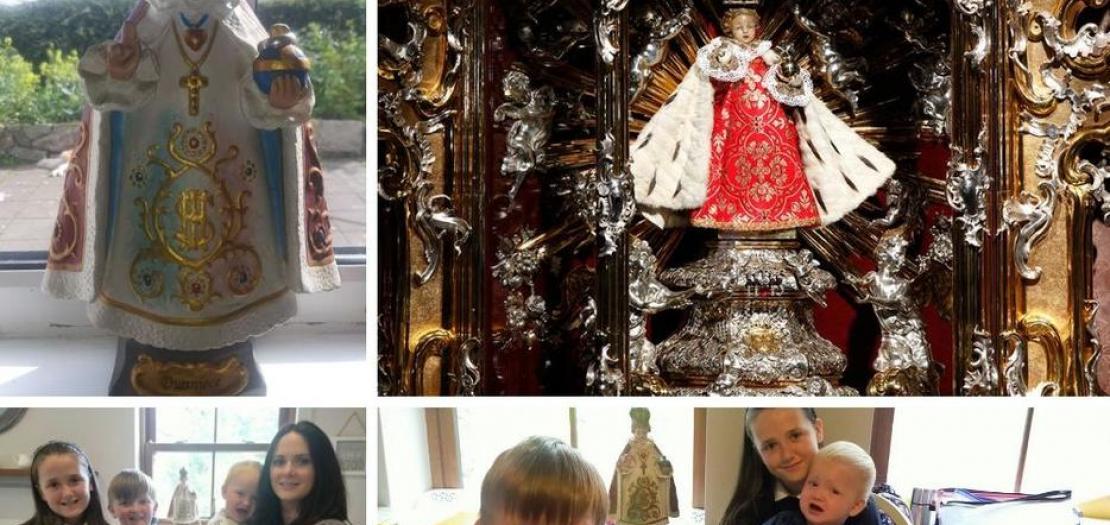Issued by the Catholic Center for Studies and Media - Jordan. Editor-in-chief Fr. Rif'at Bader - موقع أبونا abouna.org

In the charming city of Prague, located in the heart of Europe, the Carmelite Church of Our Lady Victorious is home to a revered 16th-century statue known as the Infant Jesus of Prague.
This elegant wax-coated wooden statue of the Child Jesus, complete with a golden crown, stands at 18.5 inches high below a large ornate monstrance. The left hand encircles a miniature globe, surmounted by a cross, signifying the universal kingship of the Christ Child. The right hand is extended in blessing, with the first two fingers raised to symbolize the two natures of Christ, while the folded thumb and last two fingers represent the unity and mystery of the Blessed Trinity. The statue is routinely clothed by the Carmelite nuns following the liturgical seasons of the Church.
The history of the statue is as fascinating as the sculpture itself. In the Middle Ages famous artists throughout Europe carved a number of Infant Jesus sculptures made of wax, ivory and bronze. St. Teresa of Avila is often credited with the popularity of devotion to the Child Jesus in Europe during this period, with some historical accounts claiming the Prague statue originally belonged to the Spanish Carmelite mystic herself.
In 1628, the statue was donated to the discalced Carmelites in the Monastery of Our Lady of Victory in Prague by Princess Polyxena of Lobkowicz, who had herself received the family heirloom from her mother as a wedding gift.
The statue was placed in the oratory where special prayers were said before it twice a day, and Carmelite novices professed their vows in its presence. The destructive Thirty Years’ War and subsequent invasions ended these devotions. In 1631, the city of Prague was captured by the Swedish army, and the Carmelite friary was plundered. The statue of the Infant was thrown into a pile of rubbish behind the altar, where it lay forgotten with its hands broken off.
In 1637, Father Cyril, a devout Carmelite found and cleaned the statue and placed it in the oratory for worship. While he was praying before the image, he heard the words, “Have pity on Me and I will have pity on you. Give Me My hands and I will give you peace. The more you honour Me, the more I will bless you.”
The astonished Father Cyril did not have the funds or skill to repair the hands and so he invoked the Blessed Virgin Mary for help. The Divine Infant spoke to him a second time, saying, “Place Me near the entrance of the sacristy, and you will receive aid.” Father Cyril was obedient to this request; and shortly after, the statue was fixed by a generous visitor to the sacristy.
Many miracles have been attributed to the intercession of the Divine Infant. During one invasion, the children of the city were taken to the church to pray before the shrine for protection, and they were all saved. Since 1788, the statue’s raised fingers have worn two rings, as a thanksgiving gift by a noble Czech family for healing their daughter.
In 1896, Pope Leo XIII approved devotion to the statue and instituted a sodality in its favor. Pope Pius X further organized the Confraternity of the Infant Jesus of Prague in 1913, while Pope Pius XI granted the statue its first canonical coronation in 1924. Pope Benedict XVI crowned the statue for a second time during his visit to Prague in 2009.
In Ireland, the Infant of Prague is a well-known devotion associated with providing for both the spiritual and temporal needs of families.
Reproductions of the Prague statue were commonly given to Irish couples as a wedding gift and were usually placed near a prominent window of their home. The tradition of invoking the Infant’s help for good weather for weddings is still a popular Irish custom.
Honoring the Child Jesus and venerating his divine infancy has been a long-standing devotional tradition of the Catholic Church, which comes directly from sacred Scripture. In St. Luke’s Gospel we are told that even while still in utero, the Infant Jesus caused his unborn cousin St. John the Baptist to “leap for joy” in his mother’s womb.
In the Gospels we are told how a majestic angel proclaimed Christ’s birth to astonished Bethlehem shepherds and how the mysterious Magi followed the star to pay homage to the newborn King.
The traditional Chaplet to the Divine Infant consists of praying three Our Fathers in honor of the Blessed Trinity, followed by 12 Hail Marys in honor of the 12 years of Jesus’ life, with the invocation, “The Word was made flesh and dwelt amongst us” in between.
Siobhan Dunniece, an Irish elementary-school teacher and mother of six, describes what this devotion means for her: “Praying that short chaplet daily always gives me peace regarding my children’s welfare. My Child of Prague statue sits in pride of place in our kitchen window. He has listened to many a tale over the years, and he has been our constant friend and helper.”
Faithful Catholics in Ireland increasingly speak about the importance of devotion to the Infant Child in the context of the challenge’s children face in today’s culture.
Irish singer-songwriter Shauneen Doran describes her renewed appreciation of this devotion as a mother of four.
“My Infant of Prague statue reminds me of how God intends all children to be: pure, joyful and innocent. I pray every day to the Infant that God will shower many graces and protect all children from what has, sadly, become a very anti-child world.”
Throughout his public ministry Jesus elevated children, famously declaring, “Truly I tell you, unless you change and become like little children, you will never enter the kingdom of heaven” (Matthew 18:3-4).
Many saints, such as St. Thérèse of Liseux, St. Francis of Assisi and St Anthony of Padua, had very strong devotions to the Divine Child. By following the example of these great saints, the faithful are offered a powerful spiritual remedy and a renewed hope that a genuine renewal of children’s rights and innocence in our age is possible.
Despite the seemingly insurmountable challenges to children’s welfare today, contemplating the Infant Child Jesus reminds us of that great moment of the Incarnation, that children are the hope for the future, and that with God all things are possible.
Father Darren Brennan, parish priest at Dunloy parish in County Antrim, knows well the place the Infant has in the devotion of the faithful.
“The Child of Prague embodies the virtues of humility, innocence, purity and filial love for God and Mary, a perfect antidote to many of the evils threatening families and young people today.”
Infant Jesus of Prague, victorious King, pray for us!







